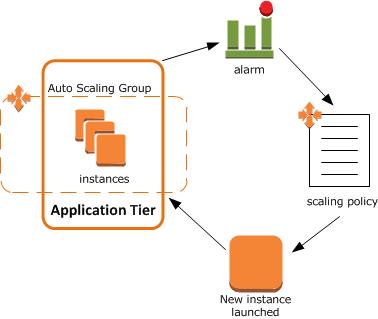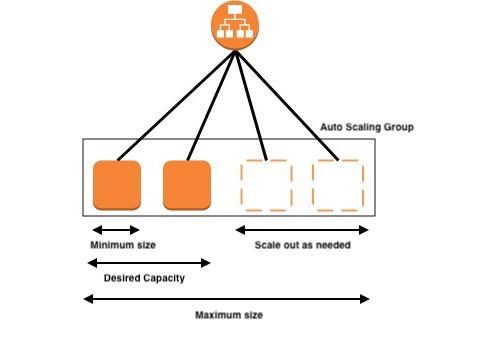What is AWS EC2 Auto Scaling?
Suppose you are new in business and just launched your application with a single server. After some time your business started growing exponentially which brings more traffic to your website but as you had a single server, and traffic on the website exceeded the capabilities of the server, customers are facing low latency issues. To overcome the problem you need more servers to be installed. Now in traditional case customers will report low latency then you will check for the problem and get servers installed by spending huge capital. This will be time-consuming, hectic, and dissatisfactory. Instead of this wouldn’t it be better if there is some service that can automatically do it for you? Introducing Amazon Auto Scaling.
Amazon AutoScaling:
Amazon Auto-scaling is the service offered by the AWS which allows us to increase or decrease the capacity of the application on demand depending on the limits we set using Cloudwatch. Auto-scaling not only helps in dealing with the servers by dynamically scaling EC2 capacity up or down but also helps in maintaining availability. It automatically adds instances when the traffic increases or removes the instance when not enough traffic is coming depending on the conditions defined by us. Amazon EC2 scaling also does fleet management and health checks of the EC2 instances. To understand better let’s look at the diagram.
We are looking at an EC2 distributed framework, where you have numerous subnets over various Availability Zones, EC2 instances that are launched inside an Auto Scaling group which means, they're similar, they can be created as per the need by Auto Scaling, all associated through the elastic load balancer. Along these lines, traffic rolling in from the outside can without much of a stretch boil down to either EC2 instances, yet, there will be more and when these instances are over-burden. At the point when they do, they will send metrics over to CloudWatch. CloudWatch is looking for the point when CPU crosses a specific line, it will tell the Auto Scaling engine that we need more EC2 instances propelled in every Availability Zone. It will happen consequently, with no people accomplishing the work.

Scaling policies:
EC2 auto scaling engine offers three types of policies:
Target tracking scaling:
It increments or declines the present limit of the gathering dependent on an objective incentive for a particular measurement. This is like the way that your indoor regulator keeps up the temperature of your home—you select a temperature and the indoor regulator does the rest. Moreover, target tracking scaling scales the resources up or down based on the target of the resource.
Step Scaling :
Increment or lessening the present limit of the gathering dependent on a lot of scaling modifications, known as step alterations, that fluctuate depending on the size of the alert penetrate. In other words, scaling up or down the size of the groups based on scaling adjustment.
Simple Scaling:
Increment or decline the present limit of the gathering dependent on a solitary scaling modification. In the event that you are scaling dependent on a use metric that increments or diminishes relative to the number of examples in an Auto Scaling gathering, we suggest that you use target following scaling arrangements. Else, we suggest that you use step scaling arrangements.
Types of Scaling:
Scheduled Scaling:
As the name suggests scaling based on a schedule. It permits you to make a schedule of the scaling before time. Suppose your site attracts more customers on the weekend so you can schedule your scaling activities according to that.
Dynamic Scaling:
In this type of scaling you dynamically can set the targets and scale according to that without human intervention. It allows you to study the application’s graph closely. For example, one can use target scaling policy t select a load metric, and EC2 auto-scaling will then automatically maintains the number of EC2 instances needed.
Predictive Scaling:
This is a more advanced type of scaling offered by AWS as it uses Machine learning to schedule the number of EC2 instances that will be needed to handle the traffic in the future. This algorithm-based approach does not only predicts the traffic coming in the near future but also predicts the changes in the pattern within a week or month or on a daily basis. It also predicts the spikes and number of spikes in traffic. It eases the developer’s work further by eliminating the need for manual adjustments of auto-scaling dimensions.
Features:
Better fault tolerance:
Amazon EC2 auto scaling is capable of noticing if something is odd with an EC2 instance and disable the same as soon as it finds something odd. One can also use Amazon EC2 auto-scaling with multiple availability zones so if 1 availability zone is unavailable, it can launch the instance in another zone and will compensate for the loss.
Better availability:
This is one of the main features that it makes the application always capable to handle the amount of traffic dogging in. It makes EC2 instance ready to handle the intensity.
Better cost management:
As AWS offers to pay as you go pricing, Autoscaling further manages the cost by eliminating the instance that is not currently used and re-launch instances when in need so that no instance is wasted.
EC2 auto scaling is one of the main and powerful services offered by AWS. If you have any doubts regarding the topic, write to me in the comment section. To read more informative articles on various topics stay connected with Tutorialslink. Keep reading and stay healthy





